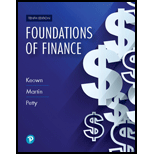
(Divisional costs of capital and investment decisions) In May of this year Newcastle Mfg. Company’s capital investment review committee received two major investment proposals. One of the proposals was issued by the firm’s domestic manufacturing division, and the other came from the firm’s distribution company. Both proposals promise a
However, managers have long recognized that the manufacturing division is significantly more risky than the distribution division. In fact, comparable firms in the manufacturing division have equity betas of about 1.6, whereas distribution companies typically have equity betas of only 1.1. Given the size of the two proposals, Newcastle’s management feels it can undertake only one, so it wants to be sure that it is taking on the more promising investment. Given the importance of getting the cost of capital estimate as close to correct as possible, the firm’s chief financial officer has asked you to prepare cost of capital estimates for each of the two divisions. The requisite information needed to accomplish your task follows:
- The cost of debt financing is 8 percent before a marginal tax rate of 21 percent. You may assume this cost of debt is after any flotation costs the firm might incur.
- The risk-free rate of interest on long-term U.S. Treasury bonds is currently 4.8 percent, and the market-risk premium has averaged 7.3 percent over the past several years.
- Both divisions adhere to target debt ratios of 40 percent.
- The firm has sufficient internally generated funds such that no new stock will have to be sold to raise equity financing.
- a. Estimate the divisional costs of capital for the manufacturing and distribution divisions.
- b. Which of the two projects should the firm undertake (assuming it cannot do both due to labor and other nonfinancial restraints)? Discuss.
Want to see the full answer?
Check out a sample textbook solution
Chapter 9 Solutions
EBK FOUNDATIONS OF FINANCE
- You want to buy equipment that is available from 2 companies. The price of the equipment is the same for both companies. Silver Fashion would let you make quarterly payments of $14,930 for 8 years at an interest rate of 1.88 percent per quarter. Your first payment to Silver Fashion would be today. Valley Fashion would let you make X monthly payments of $73,323 at an interest rate of 0.70 percent per month. Your first payment to Valley Fashion would be in 1 month. What is X?arrow_forwardYou just bought a new car for $X. To pay for it, you took out a loan that requires regular monthly payments of $1,940 for 12 months and a special payment of $25,500 in 4 months. The interest rate on the loan is 1.06 percent per month and the first regular payment will be made in 1 month. What is X?arrow_forwardYou own 2 investments, A and B, which have a combined total value of $38,199. Investment A is expected to pay $85,300 in 6 years and has an expected return of 18.91 percent per year. Investment B is expected to pay $37,200 in X years and has an expected return of 18.10 percent. What is X?arrow_forward
- You own 2 investments, A and B, which have a combined total value of $51,280. Investment A is expected to pay $57,300 in 5 years and has an expected return of 13.13 percent per year. Investment B is expected to pay $X in 11 years and has an expected return of 12.73 percent per year. What is X?arrow_forwardEquipment is worth $225,243. It is expected to produce regular cash flows of $51,300 per year for 9 years and a special cash flow of $27,200 in 9 years. The cost of capital is X percent per year and the first regular cash flow will be produced in 1 year. What is X?arrow_forward2 years ago, you invested $13,500. In 2 years, you expect to have $20,472. If you expect to earn the same annual return after 2 years from today as the annual return implied from the past and expected values given in the problem, then in how many years from today do you expect to have $55,607?arrow_forward
- You plan to retire in 5 years with $650,489. You plan to withdraw $88,400 per year for 20 years. The expected return is X percent per year and the first regular withdrawal is expected in 6 years. What is X?arrow_forwardDon't used hand raiting and don't used Ai solutionarrow_forwardDon't used hand raiting and don't used Ai solutionarrow_forward
- Don't used hand raiting and don't used Ai solutionarrow_forwardEnds Feb 23 Explain in detail what is Risk as defined for financial assets and what is Beta? Also discuss in detail what is the Capital Asset Pricing Model (CAPM) and its purpose.arrow_forwardThe slope parameter ß1 measures the change in annual salary, in thousands of dollars, when return on equity increases by one percentage point. Because a higher roe is good for the company, we think ß1 > 0.The data set CEOSAL1 contains information on 209 CEOs for the year 1990; these data were obtained from Business Week (5/6/91). In this sample, the average annual salary is $1,281,120, with the smallest and largest being $223,000 and $14,822,000, respectively. The average return on equity for the years 1988, 1989, and 1990 is 17.18%, with the smallest and largest values being 0.5% and 56.3%, respectively.Using the data in CEOSAL1, the OLS regression line relating salary to roe is :arrow_forward
 EBK CONTEMPORARY FINANCIAL MANAGEMENTFinanceISBN:9781337514835Author:MOYERPublisher:CENGAGE LEARNING - CONSIGNMENT
EBK CONTEMPORARY FINANCIAL MANAGEMENTFinanceISBN:9781337514835Author:MOYERPublisher:CENGAGE LEARNING - CONSIGNMENT Intermediate Financial Management (MindTap Course...FinanceISBN:9781337395083Author:Eugene F. Brigham, Phillip R. DavesPublisher:Cengage Learning
Intermediate Financial Management (MindTap Course...FinanceISBN:9781337395083Author:Eugene F. Brigham, Phillip R. DavesPublisher:Cengage Learning

